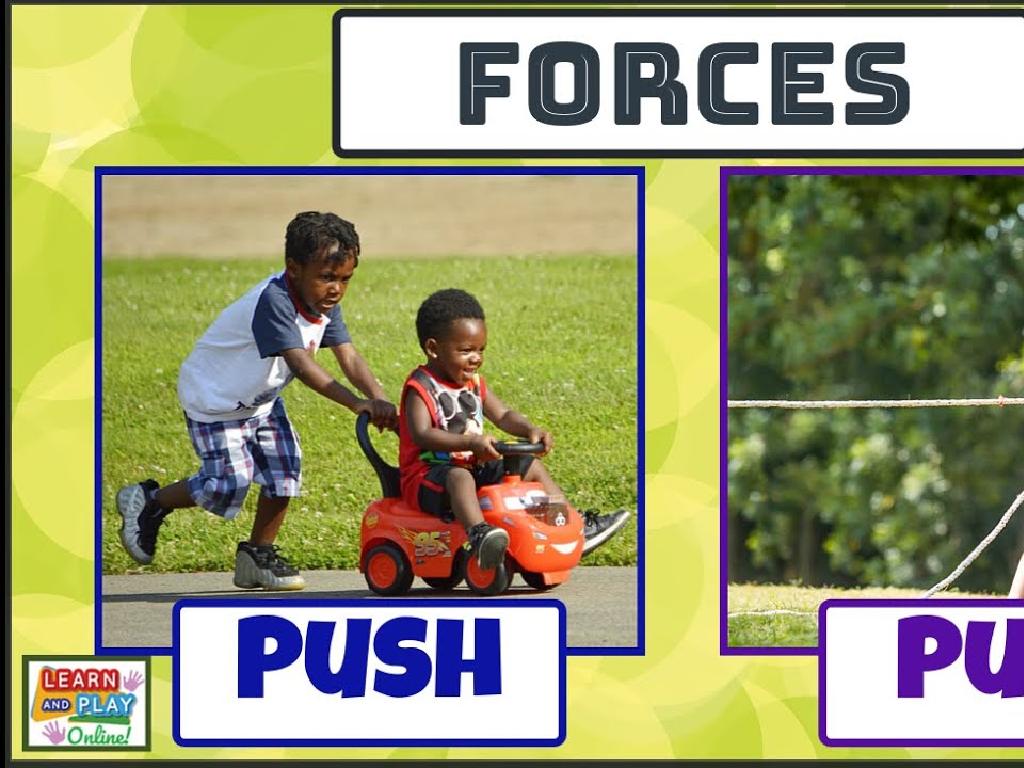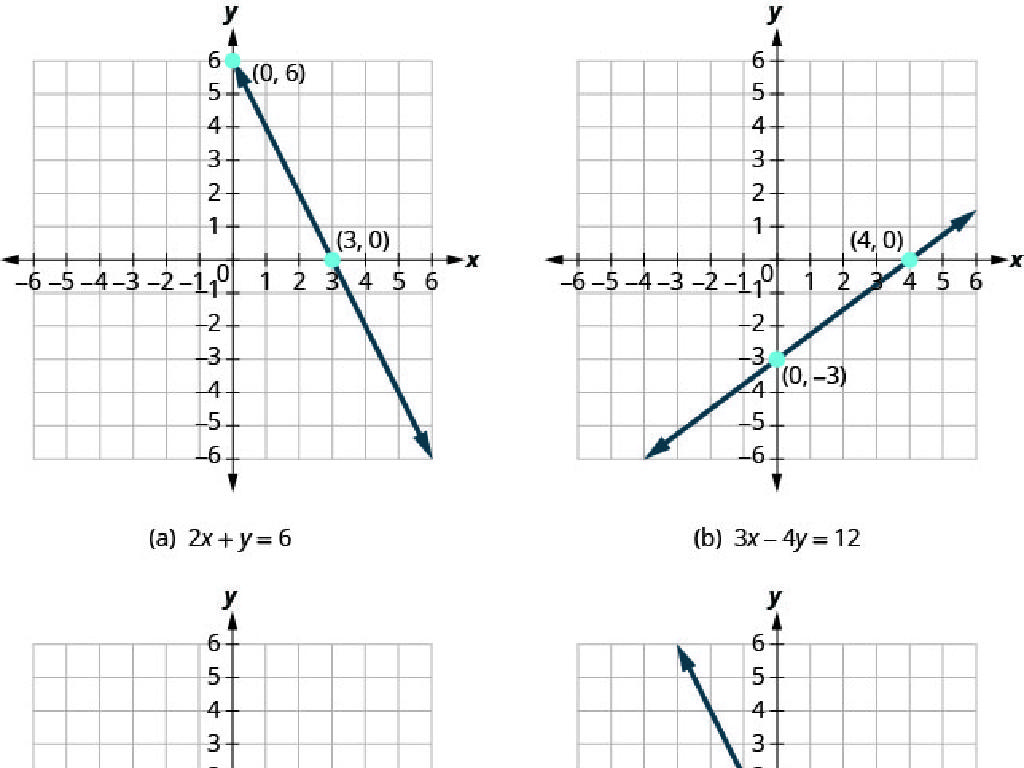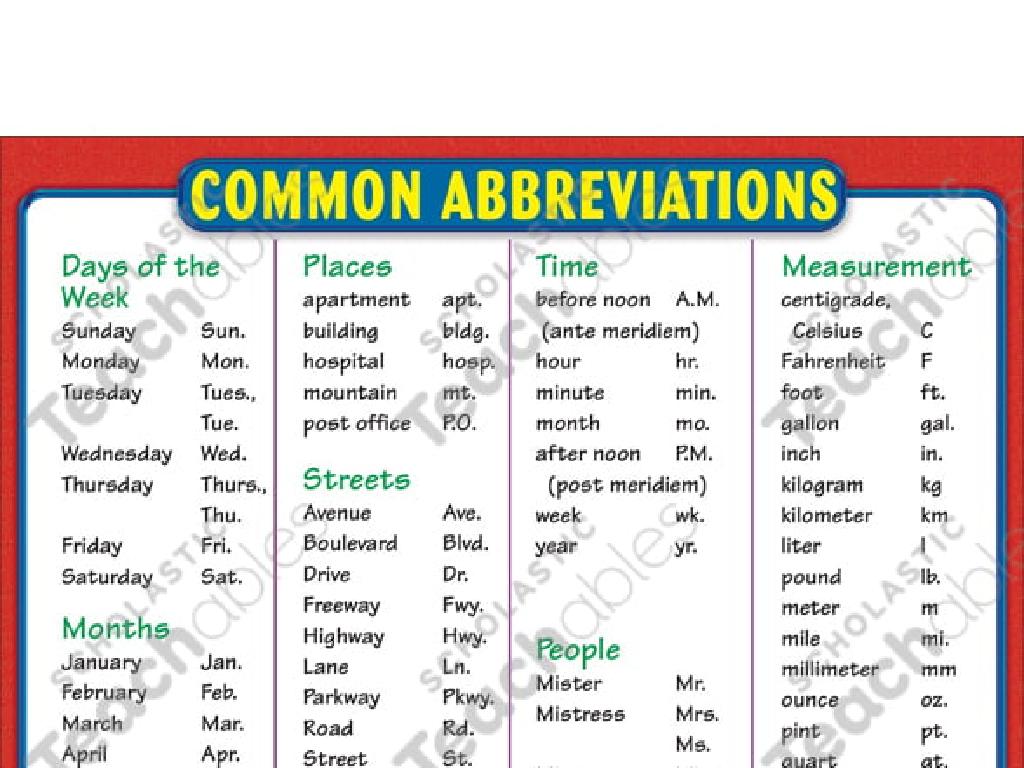Number Lines - Up To 30
Subject: Math
Grade: Kindergarten
Topic: Numbers And Counting To 30
Please LOG IN to download the presentation. Access is available to registered users only.
View More Content
Welcome to Numbers: Exploring Number Lines
– Greetings, young mathematicians!
– Today’s adventure: number lines
– A number line is a straight path with numbers in order
– Numbers are our counting friends
– We use numbers to count toys, cookies, and days
– Uses of numbers in daily life
– Numbers help us know ‘how many’ and ‘what time’
|
This slide is designed to introduce kindergarteners to the concept of number lines, which are fundamental tools in mathematics for understanding order and value. Start by welcoming the students and creating an atmosphere of excitement about learning math. Explain that number lines are like stories that numbers tell from the beginning to the end, and they help us see the order of numbers. Emphasize the practicality of numbers in everyday life, such as counting objects and understanding time. Use simple and relatable examples to illustrate the point. Encourage the children to think of numbers as helpful tools that make sense of the world around them.
Exploring Number Lines
– What is a number line?
– A straight line with equally spaced numbers
– Numbers in order on a line
– Shows how numbers come after each other
– Counting forward on the line
– Start at 1 and hop to the right to 30
– Counting backward on the line
– Start at 30 and hop to the left to 1
|
Introduce the concept of a number line to the students as a foundational tool in mathematics. Explain that a number line is a visual representation of numbers in a sequence, with equal spaces between them. Demonstrate how to use a number line by starting at the number 1 and moving to the right to count up to 30, emphasizing the concept of ‘forward.’ Then, show how to count backward by starting at 30 and moving to the left back to 1. Use a physical number line in the classroom for demonstration and encourage students to practice with their own number lines. This will help them understand the order of numbers and the basics of addition and subtraction.
Counting to 30 on a Number Line
– Counting from 1 to 30 together
– Each number is one more step
– After 1 comes 2, then 3, and so on
– Count objects like toys or crayons
– How many crayons are in the box?
– Practice counting with real steps
– Let’s walk and count each step we take
|
This slide is aimed at helping Kindergarten students understand the concept of counting to 30 using a number line. Start by engaging the students in a fun counting activity where everyone counts aloud together. Emphasize that each number on the number line represents a single step forward from the previous number. Use tangible objects like toys or crayons to make counting relatable and concrete. For a kinesthetic learning experience, have the children count their steps as they walk in a line. This multi-sensory approach helps solidify the concept of sequential order in numbers. Encourage the students to visualize the number line as they count and to use their fingers to point to imaginary numbers in the air as they go.
Fun with Number Lines
– Jump forward to add numbers
– Like hopping: 1 to 2 is a small jump forward!
– Jump backward to subtract
– Like stepping back: 5 to 4 is a small jump backward!
– Practice jumping on the line
– Let’s jump to 5, then 10, then 15!
– Find numbers up to 30
– Can you jump to 20? How about 30?
|
This slide introduces kindergarteners to the concept of using a number line as a visual aid for basic addition and subtraction. Explain that moving to the right on the number line means adding, and moving to the left means subtracting. Use physical movements, like jumping, to help them understand the concept of ‘jumping’ to numbers. During the activity, encourage students to stand up and mimic jumping forward and backward to visualize the math concept. This kinesthetic approach helps solidify their understanding of number sequences and basic arithmetic. Make sure to praise their efforts and correct gently if they make mistakes.
Exploring the Number Line
– Locate the number 10
– Look for 10, it’s after 9
– Find the number 20
– 20 is two times as much as 10, let’s count
– Identify all numbers up to 30
– We’ll point to each number from 1 to 30
– Practice counting on the line
|
This slide is designed to help Kindergarten students become familiar with the concept of a number line and how to find specific numbers on it. Start by asking them to locate the number 10, which is a foundational benchmark number for young learners. Then, move on to finding the number 20, emphasizing that it is double the number 10. Encourage the students to count aloud as a group from 1 to 30, pointing to each number on the number line as they go. This will help reinforce their counting skills and number recognition. As an activity, you can have students walk in a line, stepping on numbers laid out on the floor, to physically move along a number line. This kinesthetic approach can be very effective for young learners.
Number Line Games for Fun Learning!
– Number lines can be fun
– Play hopscotch to learn numbers
– Hopscotch has numbers in order, just like a number line
– ‘Jump to the Number’ game
– Call out a number and jump to it on the line
– Create your own number line
– Use chalk or tape to make a number line up to 30
|
This slide introduces interactive games that utilize the concept of a number line to make learning numbers up to 30 engaging for Kindergarten students. The idea is to incorporate physical activity with learning to enhance the children’s experience. Hopscotch is a familiar game that naturally teaches the sequence of numbers. ‘Jump to the Number’ is an activity where a number is called out, and children must jump to the correct position on the number line. Encourage creativity by allowing the students to create their own number lines using classroom materials. This hands-on approach helps solidify their understanding of numerical order and counting. Prepare to facilitate these games and have alternative options for children with different mobility levels.
Let’s Practice Number Lines!
– Draw your number line
– Mark numbers up to 30
– Fun counting exercises
– Counting jumps, finding numbers
– Share with the class
– Show your number line to friends
|
This slide is for a hands-on activity where students will create their own number lines up to 30. Provide them with long strips of paper and markers or crayons. Guide them to draw a straight line and help them mark the numbers at equal intervals. Once their number lines are ready, engage the class in fun counting exercises such as ‘jumping’ to every fifth number or finding a number that the teacher calls out. Encourage students to count aloud together to reinforce their understanding of the sequence of numbers. At the end of the activity, allow students to share their number lines with the class, fostering a sense of accomplishment and allowing them to see variations in their classmates’ work. This activity will help solidify their understanding of number sequences and the concept of intervals on a number line.
Class Activity: Create Your Number Line
– Receive a strip of paper
– Draw numbers 1 to 30
– Practice writing numbers in order
– Decorate with stickers
– Use colorful stickers or drawings to make it fun
– Display our number lines
– Show off your work in the classroom
|
This activity is designed to help Kindergarten students understand and visualize the concept of a number line. Provide each student with a long strip of paper. Guide them through drawing evenly spaced marks and writing numbers from 1 to 30 in order. Encourage creativity by allowing them to decorate their number lines with stickers or drawings, which will make the activity enjoyable and memorable. Once completed, have the students display their number lines around the classroom. This will not only reinforce their counting skills but also give them a sense of accomplishment. For differentiation, some students may only go up to 10 or 20, depending on their comfort with numbers.
Number Line Mastery: Counting to 30
– Congratulations on learning number lines!
– Counting to 30 with a number line
– Use a number line to count from 1 to 30
– Number lines help us count
– Imagine a number line as a ladder, each step is a new number
– Keep practicing at home!
– Try drawing your own number line and use it to count toys or snacks
|
This slide is a celebration of the students’ achievement in learning how to use number lines to count up to 30. It’s important to reinforce the concept that number lines are useful tools that can help them visualize counting. Encourage the children to keep practicing with number lines at home, perhaps by including family members in their learning process. Suggest that they draw their own number lines and use them in practical counting exercises, like counting their toys or snacks. This will help solidify their understanding and make counting a fun activity.
Activity Time: Number Line Hopscotch
– Play hopscotch on a number line
– Listen for the number to hop to
– Hop to the called out number
– Have fun learning numbers!
|
This activity is designed to combine physical activity with number recognition for an engaging math lesson. Create a large number line on the floor with numbers up to 30. As you call out a number, students will hop to the corresponding spot on the number line. This helps with number identification and reinforces the sequence of numbers. For variation, you can ask students to hop to the number that comes before or after a number you call out. You can also have students hop in increments of two to introduce the concept of even numbers. Ensure safety by spacing out students and supervising the activity closely.






